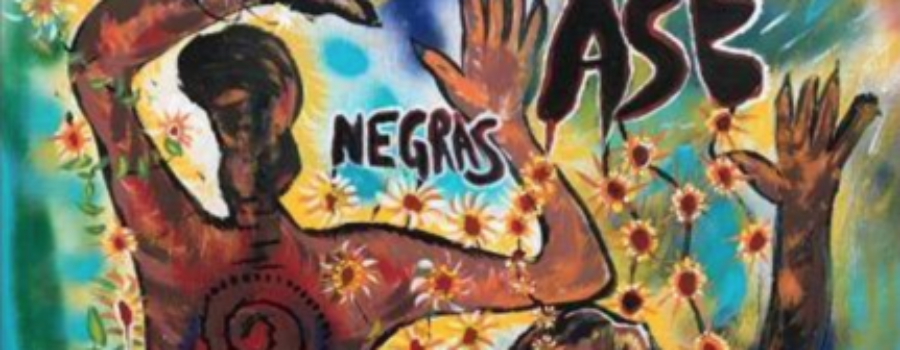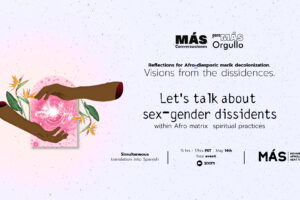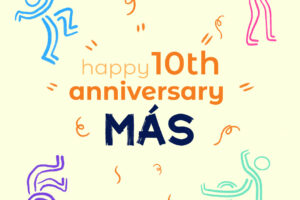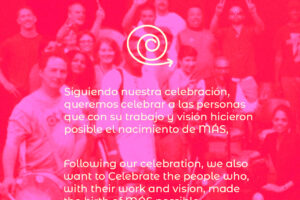We invite Meyby Ugueto-Ponce and Franklin Perozo to share their impressions and reflections with the MÁS community, after participating in Dialogue #2: Black Lives Matter and the importance of making blackness visible, from the first series of conversations ‘MÁS Conversations for MORE Pride’, on July 4.
Spanish below
English translation: Yen Baynes
The nature of current interactions, regarding protection measures against contagion by coronavirus, has intensified the use of communication technologies, especially for those of us who have the “privilege” of being able to comply with social distancing and that we also achieve have access to a part of the technological universe, which today’s communications imply. At the same time, it has been a window to facilitate new meetings and connections, which seemed to have been almost impossible months ago. For us, this “new normality” allowed us to interact, after the invitation of two Venezuelan friends, with part of a Latino community in the US, linked to the Seattle Afro-Latin Movement (MÁS) in a very pleasant conversation about one of the the issues that, as a Latin American region, unites us. We discussed a historical narrative that was built, from our early birth as republics, based on the idea of the harmonious unification of the nation that would be achieved thanks to the supposed “mixing of races”, a discourse that has even lasted until today, and as contradictory as it may seem, it also continues to be promoted by the white-mestizo elites in the countries that have legally materialized multicultural proposals in the constitutional order. We refer to the idea of miscegenation.
In this case, the question about this idealized phenomenon as a founding political project in the region, which was based on the supposed union of the three racial components, Latin America the melting pot of diversity, that idea of cosmic race, of coffee with milk as met him in Venezuela, it was an ideological project that made the cultural differences that constituted our nations invisible, protected by a veiled whitening, sustained by racist ideals to build an apparent society of equals. This problem emerged for this Latino community in Seattle, due to the different responses that have arisen in American society, due to the rejection of the murder of the African-American George Floyd at the hands of the violence exerted by a police officer, a situation that generated a wave of protests. against the normalization of the brutal maneuvers of the security forces against Afro-Americans, protected by the most damaging white supremacist ideals. But this doubt, which worried Puerto Ricans, Peruvians, Hondurans, Dominicans, Chican@s, Venezuelans, Brazilians, etc. located in the north of the continent, I questioned them precisely because of the uncertainty that occurred when this great ideological veil that miscegenation meant, does not seem today to sustain the certainties of social inclusion that it promised when it was erected in our countries at the beginning of the 19th century. Above all, when the idea of “what is Latinx” has no place within the hegemonic identity of the United States, which makes one question one’s own place, one’s own history, and one’s own being, in a context where the demands of others to preserve the life, they seem to summon theirs.
How much does anti-black racism have to say about Latin@s in the US? In addition to the solidarity expressed by the demand for justice in the face of the inhumane murder of Floyd and in the face of the evidence of a justice system racialized, what coincidences and divergences exist between the struggle, for example, of Black Lives Matter and the demands of the Latin@s movements in the US, while there is a founding historical horizon in the transatlantic trade that unites them? At what point was the story of difference-enmity, if it exists, built between Latin@s and Afro-Americans? But at the same time, to what extent does the criminalization of both sectors unite them, while bringing them together in the non-white American sector? To what extent does the Latin@ category make the ethnic and cultural diversity of the region invisible, while denying the indigenous and Afro historical and cultural components that are also diverse? Could this double denial of ethnic specificities and non-whiteness be interpreted as a form of racism equal to or perhaps even worse than that suffered by African-Americans?
We felt that these were the questions that sustained the dialogues of that conversation. The certainty for who one is, was no longer such, the need for a new categorization or not, was not yet agreed upon. Which left room for the awareness of uncertainty, for doubt, to start over, to reinvent oneself; to realize that we are facing the possibility of “A mirror without glass”. This phrase was used by a Garífuna man from Honduras to close the interpretation of his personal experience of the discussion, a powerful image that shows us that the problem of identity remains at the center of the discussion in our post-colonial countries, presenting the possibility of that by recognizing ourselves in the other, we see ourselves, when I look at my image in the mirror, I also see you. We recognize ourselves within the same historical and cultural horizon, which places us in front of the same forms of exclusion before a system that makes us invisible.
In Puerto Rico we use “race mixture” to refer to miscegenation; “trigueña” is the word used most frequently in Peru; “we are mulattoes” is widely used to say that “we are the same”; and thus words such as black@, moren@, indi@, etc., emerged as consciously colonial categories for all those attending the meeting. Or that of “Chicana” as a necessary clarification to politically denounce the ravages of colonialism within the United States. Words with strong affective ties were these, but at the same time with the need for them to be problematized within the context of migration in which they find themselves or of diversity in the face of the prevailing homogenization. The historian Ileana Rodríguez Silva, set the table to open this discussion, emphasized the use of these categories based on the commodification of human beings, as a form of racialized exploitation to fulfill the political projects of white elites. Just on that day, July 4, it was necessary to question in what sense “the freedom of some had been preached over the slavery of others.” The way the conversation unfolded showed one of the functions of miscegenation as an ideology: the use of the violent identity mechanism as a way to exclude racialized communities from the benefits of citizenship.
What was then this “mirror without glass”? It seemed to us a powerful metaphor from which we can start to generate questions. But let’s dwell a bit on it to scrutinize some meanings that we give it. Which, by the way, we do not know if they are the same ones that Wilbor Guerra awarded them that afternoon. But allow us the audacity. A mirror is a glass provided with a smooth material that allows reflections to be created, which needs light to show the objects, things, animals or people placed in front of it. If this glass does not exist, it means that there is no reflection, but it does not necessarily imply that it does not exist or that there is nothing or no one in front of it. Let’s think about standing in front of that mirror without glass, if there is no reflection there is no image of ourselves, without necessarily denying our existence. But in this case it was a common-unit sitting in a circular way (albeit through the virtual) engaging in dialogue. If all of us and each one of us who were there, had had that mirror without glass, which Wilbor told us about, the reflection that would be produced would be the image of the other, with whom we were in that virtual room. Other and diverse identities, of different, distant territorial origins, with histories of ethnicity, miscegenation and particular whitening, and with resistance responses that are also their own; linked around the complexities and contradictions that migration imposes.
The questions that this metaphor entails to problematize the individualities that congregate in MÁS, run between what are the particular histories of conformation of the idea of miscegenation in the countries from which they originate; which ethnic accents are preferred; to what extent this is related to citizenship as a possibility of accessing the benefits of the nation; what is the status of all that historical particularity within the US; how to enrich the category of latinidad from the recognition of common historical trunks; what are the communicating vessels between the different sectors of Latin America and the oppressed sectors of the US, such as Afro-Americans, for example. Certainly a long road, but not impossible to travel. How? The virtual meeting also showed the way, ways of being that are part of that common reflection in which Latinos recognize themselves in the new common space: solidarity as one of the main ones, but mainly attending to diversity. That is why there was talk of a “solidarity multiraciality”, insofar as the multiple existing diversities are recognized and accepted, in order to be able to weave binding ties without leaving anyone out. This mirror allows us to recover some of the strengths of Latinity, we said that solidarity is the main service for the construction of extended families, the territorialization of new identities is another, the African diaspora knows a lot about it; and the possibility of updating the common history as the central vein of the processes of cultural reconstruction, such as the project of “De Cajón Project” directed by Mónica Rojas, or the Afro-Venezuelan festivities in honor of San Juan shared by Milvia Pacheco, or the conversations with Master Silvio Dos Reis about Capoeira, among many other experiences of reconstruction of cultural memory that come together in MORE.
There are infinite paths through which dialogue builds links, just like a river that expands and divides to irrigate the land, talk problematizes, refreshes and feeds us in these fateful times we live in; it opens the possibility of seeing ourselves in the others and offers us ways of seeing life linked to our stories, those that shape and accompany us, but that have suffered death blows by Western civilization. Having put on the table a complex and painful issue for everyone, continues to leave the possibility to build a us, linked from common feelings and needs, because there are many more proximity than distance, because despite borders and the logic of the individual, it was possible to hear and understand each other, see and recognize each other, to continue inventing forms and ways that lead us to transformation.
By Franklin Perozo and Meyby Ugueto-Ponce
Caracas, Venezuela – July 16, 2020

Meyby Ugueto-Ponce
Afro-Venezuelan, Caracas, descendant of free black towns: Curiepe and La Sabana. Researcher and activist of the African diaspora. Interpreter, teacher and researcher in traditional Venezuelan dance. She is part of the “Insurgent Braids” Collective of Black, Afro-Venezuelan and Afro-descendant Women; Currently co-coordinates the Collaborative Project on food: Flavors of Afro Memory. Director of “Trama Danza”, Group for Research and Promotion of Dances of Afrodiasporic Origin.

Franklin Perozo
Franklin Perozo Díaz Venezuelan, Caracas, TSU Administration, mention in Marketing, Bachelor of Philosophy, M.Sc. in Comparative Literature, Photographer, Researcher and Curator of the Contemporary Art Museum of Caracas “Armando Reverón”. Professor at the School of Modern Languages of the Central University of Venezuela. I am interested in the intersection between Philosophy, Afro-Caribbean Literature and Visual Arts, with an emphasis on narration as a way of understanding ourselves from other historical horizons.
















